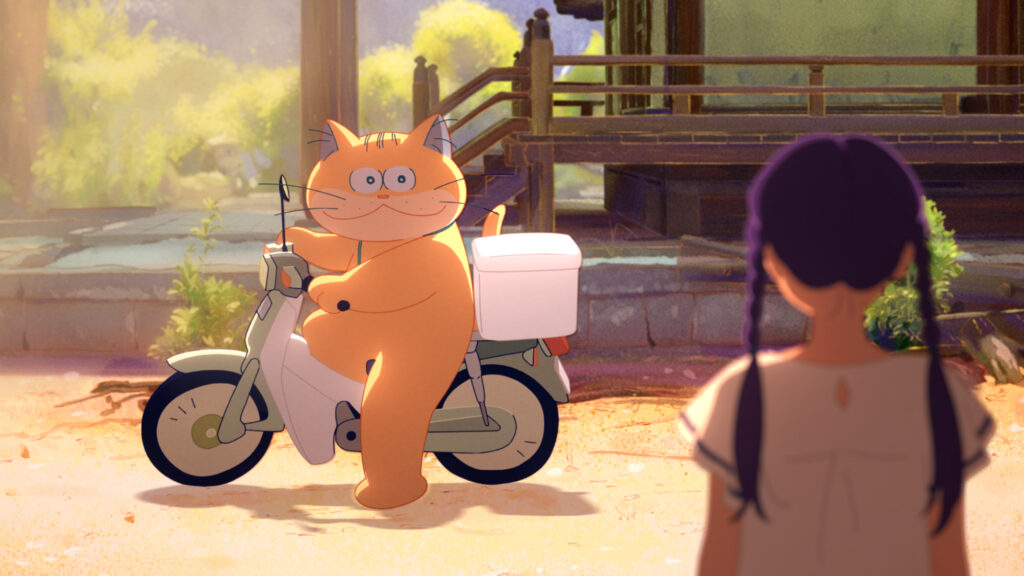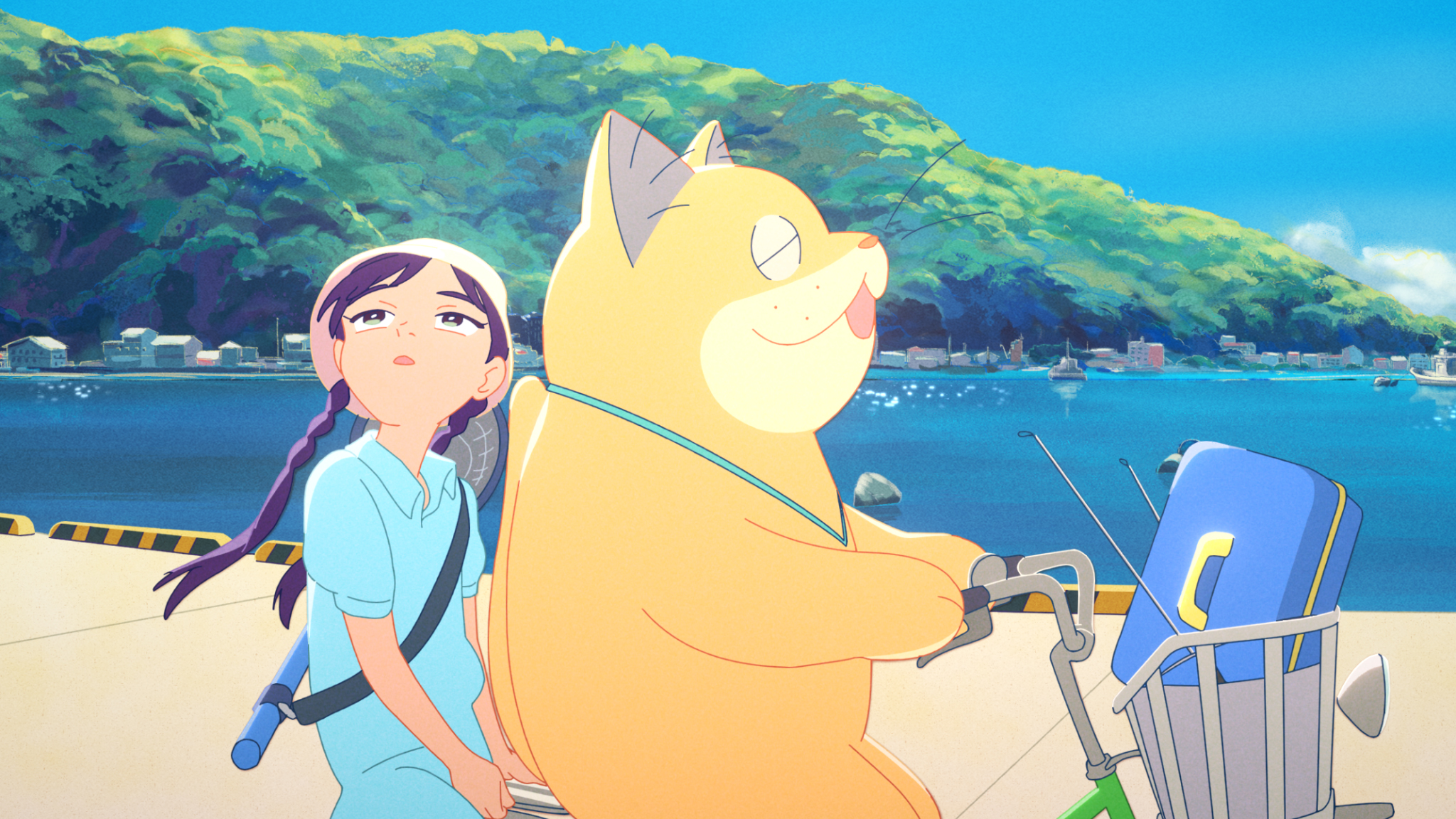Based on Takashi Imashiro’s manga of the same name, GHOST CAT ANZU directed by Yôko Kuno & Nobuhiro Yamashita is a beautiful animated film that is a remarkable example of what is possible when excellent writing, directing, production, and performance all come together.
GHOST CAT ANZU is Beautiful, but Boring
The film’s production was tremendously time intensive.
It was first shot entirely as a live-action.
After that, extensive rotoscoping animation techniques were utilized to allow a deeper communication of unimaginable nuances in performance.
With traditional animation, the images on screen are both created by and limited to the animator’s imagination. With rotoscoping, they were able to capture certain subtleties of character expressions that might have been overlooked with traditional animation. Things like uneven breathing, unexpected movements, and candid interactions.
Because of this production process, the film has a distinct feeling and experience of realism despite being fully and vibrantly animated.
Yes, it is an aesthetically pleasing watch filled with gorgeous composition, coloring, and lighting. But, beyond that, there’s a hidden, but still apparent “human” quality and energy behind every scene that truly makes the film beautiful.
The Story is Boring
The story follows Karin, a witty and dismissive 11 year old, after she gets dropped off at a temple by her deadbeat, gambling-addict father.
Soon after being left in the care of her grandfather, who is the monk of the temple, Karin meets the titular “Ghost Cat,” a 6-foot tall anthropomorphic talking cat, named Anzu.

At first, the two are standoffish because of clashing personalities.
- Anzu is laid back, goofy, and carefree.
- Karin is a bit more cynical, critical, and firm.
When Karin questions the logistics of Anzu’s existence and his ability to talk, Anzu’s response is more or less, “because of course I can, why wouldn’t I be able to?”
Note: This type of deadpan humor within the “rules” of the spiritual domain and the absurd is the delightful tonal center of the entire story. One scene has the Ghost Cat receiving a traffic ticket for operating a moped without a license. Anzu’s argument is that he’s a cat and therefore can’t get a ticket. The police officer’s response is that while that may be true, Anzu is a 37 year old cat which makes him old enough to get a license – therefore – is at fault for driving without one and deserves a ticket.
After introducing the primary characters, the film meanders for a while in the first half, with everyone seemingly just going about their daily lives in ways that don’t necessarily affect the plot.
- We follow Karin as she tries to find her place in this new town. She meets some other kids and some other spiritual entities who sympathize with her story.
- We follow Anzu as he does odd jobs around the island. He also does oddly “normal” stuff, like cook, drink beer, and check in on his friends.
The “plot” doesn’t pick up until around the halfway point of the film, when Anzu escorts Karin to the underworld to help her fulfill her desire to talk to her recently deceased mother.
The unlikely duo end up literally bringing Karin’s mother back to the world of the living. Unfortunately, their attempt is futile because the King of Hell chases after them and ultimately takes the mother back to Hell.
During their final moments together, Karin is able to express her love to her mother and accepts that she has to let her go and live on without her.
Shortly after that, the story concludes with the world finishing in the exact same configuration as it was when the story started.
- Karin is still at the temple.
- Her father is still out of the picture.
- Anzu is still a crude talking Ghost Cat.
The only significant difference is now Karin has new friends, a new “found-family,” and a deeper appreciation for (vs repulsion of) where she is in life.
Feelings of Boredom
For many people, despite the film’s apparent beauty and craftsmanship, the narrative structure feels a bit lacking.
For most of the first half of the film, although we learn about characters, they really don’t do anything to progress the plot.
Then, when things actually start happening, there’s nothing objectively gained other than, “the friends we made along the way.”
When watching the film’s first half, I found myself feeling a little bored.
Sure, the images on screen were delightful, cute, and clever, but the reason we go to cinema in the first place is to experience something that transcends everyday life.
Seeing a giant cat do regular people stuff is funny at first, but the novelty wears off after one or two scenes.
Despite these initial feelings, I figured there must be a purpose for those moments. The filmmakers essentially made the film twice. Once in live action and once in animation.
This is significant because in order to even make it to the big screen, those “boring” scenes had to face twice as many creative decision crossroads and survive.
The mundane moments were there for a reason.
The more I sat with what was presented and thought about what the material was trying to say as opposed to what my taste wanted it to say, the more I was able to find meaning and purpose within the mundane.
For me, the meaning particularly shines through when analyzing the story in the context of the film’s theme – grief.
This is a Story About Grief
Grief is a unique and harrowing experience that is directly related to love and loss.
The more you love someone or something, the more it hurts when that thing is lost and the longer it takes to process that loss.
Within our lifetimes, we may meet and interact with thousands of people. And every day, many of those people will either be literally or metaphorically lost to us. Despite “losing” so many people all the time, we will only ever grieve the ones with whom we make truly special connections.
In a weird way, within one’s lifetime, one’s grief may only ever be as great as one’s capacity to experience love.
The more unique a feeling of love is, the more dreadfully painful the grieving process will be.
Here, the word “unique” is less used as a subjective quality of excellence, but more so a distinguishing objective analysis.
- There are many people that are parents in the world.
- There are only two people that are your actual biological parents.
Your relationship to your parents (biological or not) is unique to you because only you will ever experience them as such.
The grief of losing a parent is a unique experience that at most can only ever be experienced once or twice.
Note: I acknowledge and understand that everyone’s family dynamics and upbringings are different, this is just an example for this article for this story.
Grief in GHOST CAT ANZU
This story is undeniably about grief and loss.
Specifically, the unique grief that comes with losing a parent.
Before the plot even begins, the inciting incident for the events that transpire is the death of Karin’s mother.
It is specifically because of this loss that the story even takes place.
- This loss causes Karin’s father to succumb to the allure and thrill of gambling (he’s still a deadbeat dad, but he’s a deadbeat dad with an origin story).
- That addiction causes him to abandon his daughter. Which is where we start the plot.
- And to some extent, that loss is what defines most of Karin’s personality. She’s mature for her age and a little grumpy at times, but only because she’s actively and desperately trying to fill the space and energy left behind by her mother’s passing.
When experiencing grief, it feels like a never ending nightmare where the only thing that feels real is pain.
In those moments of suffering, the core desire is simply to not be in pain anymore and for many people, the only path toward that outcome is attempting to bring the world back to what it once was.
We see this in Karin’s desire to quite literally bring her mother back from the underworld.
Sadly, the reality of grief is that the only way forward is through. You cannot rewind. You must accept.
GHOST CAT ANZU goes to great lengths to make this apparent.
The story draws heavily on elements of magical realism.
The story world is filled with spirits and supernatural entities, but it draws a hard line on the limits of what this magical world can do.
- Ghost Cat? All right.
- Giant friendly frog monster? Sure.
- Forest spirits? Checks out.
But the ability to actually bring back someone from the dead?
No.
Not happening.
Even in a magical world filled with magical things, grief is something that cannot be processed magically.
The only way to overcome grief is to fully accept the reality of it.
It is within the nature of love and loss that things are – lost.
It is only after Karin accepts the fact that her mother is gone and she lets her go does her feeling of grief finally dissipate.
The Mundane Antithesis of Grief
Where grief is a deeply personal and singularly rare experience, “the mundane” is kind of the opposite.
- Grief is hyper specific and far from normal.
- Mundanity is nothing noteworthy. It is plain, boring, and extremely normal. And that is tremendously important.
At the end of the day, when we lose someone or something, of course we miss the peaks and the spikes. The hyper stimulating beautiful memories that are only possible because of that unique relationship and love. But more than anything, we long for the boring everyday moments.
The excessive and abundant time in between those scarce sparks of love. The days that – while experiencing them – seemed to be completely and totally normal.
With grief, the want is for things to go back to what was once normal. However, because of the reality of loss, this is not possible. Therefore, the true need is for things to become a new normal. And in order for things to actually feel normal – they must be boring.
Boredom is a signifier of normalcy.
GHOST CAT ANZU is Beautiful because it is Boring
Thematically, GHOST CAT ANZU makes an argument for the purpose and power of “boredom” particularly in the lens of its relationship toward grief.
- We start with the mundane.
- We end with the mundane.
However, because of the journey of processing grief in the middle, we (like Karin) have a new found appreciation of it.
- We start the story in a place of grief, hating the mundane.
- We end the story in a place of safety, feeling gratitude toward the mundane.
At the end of the day it’s still just a story bookended by fart jokes made by a 6 foot tall anthropomorphic Cat, but the thing is the second time around, there’s gratitude for that goofy, irreverent, ordinary life.
Karin no longer despises the environment she’s been abandoned in.
In fact, she actually and decisively chooses to stay, despite her father returning to offer her a way out.
It is only after she truly accepts her new reality that she is able to embrace the hidden beauty of it that she previously overlooked.
Hidden, subtle, unimaginable beauty . . . sounds familiar, right?
Yes, this is the exact theme and concept that the production process was aiming to uncover and communicate:
The expression and articulation of soft, subtle, but realistic human experiences that are truly beautiful.

Myka Arakawa is a creative rogue born and raised in Hawai’i, with a passion for storytelling and the creative process. He holds a deep curiosity for the true nature of creative expression and has explored modes such as fiction, nonfiction, poetry, screenwriting, guitar, music production, graphic design, web design, cooking, and jiu jitsu. Myka believes in the power of creative work as a positive sum solution that can change the world, for the better for forever, and for everyone. His mission is to capture, preserve, and further the culture of his home.
The HIFF ONLINE CREATIVES & CRITICS IMMERSIVE (HOCCI) program supports sustainable film criticism in Hawai’i through mentorship and paid career opportunities for Hawai’i-based AANHPI critics. The mission of HOCCI is to broaden diversity in film criticism across the Pacific and use influencer branding strategies to spark career opportunities. The 2024 HOCCI is supported by Critical Minded, a grant-making and learning initiative that supports cultural critics of color in the United States.



